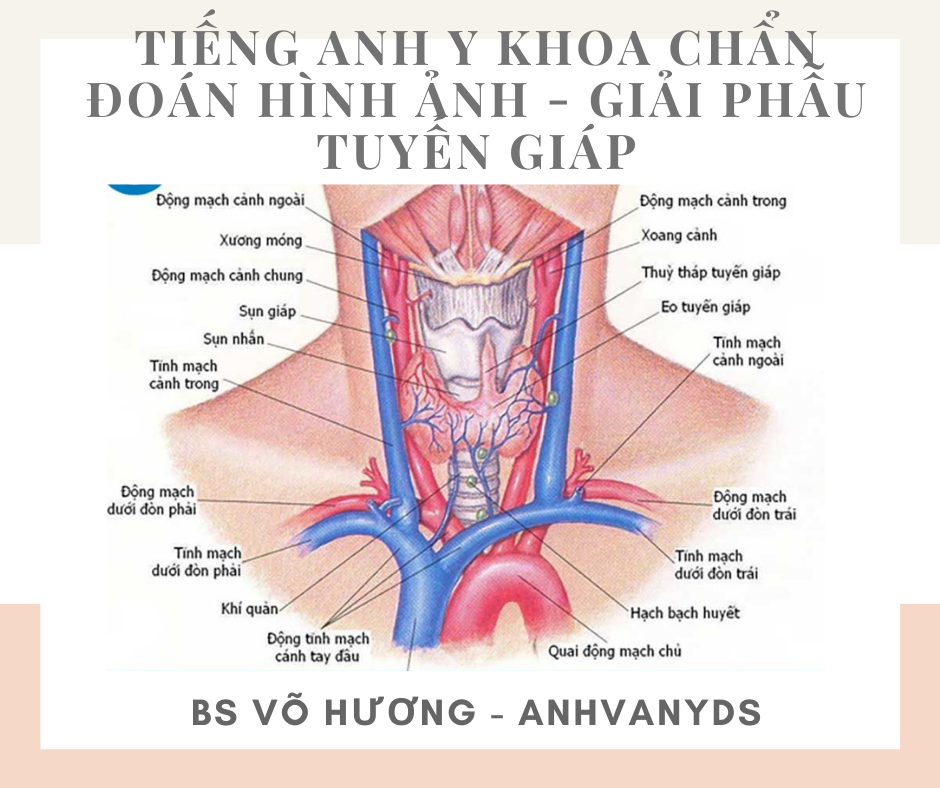
THỰC TẬP DỊCH
Các bạn hãy thử dịch một số đoạn dưới đây để vừa ôn lại kiến thức vừa học thêm từ vựng về đặc điểm hình ảnh và phôi thai học tuyến giáp.
Hướng dẫn: Tự dịch tiếng Anh sang tiếng Việt, sau đó click vào translate để hiện ra bản dịch và so sánh với cách dịch của mình.
1. Embryology
Phôi thai học
The thyroid gland develops from the proximal primitive foregut between the first and second pharyngeal pouches at the foramen cecum, in the midline of the base of the tongue.
During the 5th embryonic week, a diverticulum forms at the foramen which inferiorly migrates anterior to the body of the hyoid bone, curving posterior and superiorly to reach behind the bone before once more turning inferiorly and continuing anterior to the larynx, forming the thyroglossal duct 1,3,7.
The tip of the duct bifurcates, forming the two lobes of the gland. The parafollicular cells (C cells) responsible for calcitonin production are derived from separate tissue, the ultimobranchial body, a small diverticulum of the fourth pharyngeal pouch.
2. Radiographic appearance
Điểm về hình ảnh:
Ultrasound – Siêu âm
• the normal thyroid gland has a homogeneous appearance
• the capsule may appear as a thin hyperechoic line.
• each lobe normally measures:
length: 4-7 cm
depth: <2 cm
isthmus <0.5 cm deep
• volume (excluding isthmus, unless its thickness is >3 mm) 10-15 mL for females – 10-15 mL ở nữ
12-18 mL for males – 12-18 mL ở nam
3. Inflammatory conditions: thyroiditis
3.1. Autoimmune
• Graves disease – Bệnh Graves (Basedow)
• de Quervain thyroiditis (subacute granulomatous)
postviral
associated with HLA-B35
acutely there is an increase in thyroid hormone, with a resultant decrease in TSH. As a result there is a decrease in 131I uptake; eventually, however, the main phase is that of a hypothyroid state
• Subacute lymphocytic thyroiditis/ silent thyroiditis
painless
young women, especially in postpartum period
gland is usually normal in size, or minimally increased
usually an early hyperthyroid state which returns to normal, but may have a transient late hypothyroid period.
Hashimoto thyroiditis – Viêm giáp Hashimoto
F>M 10:1 – Nữ/ nam: 10: 1
associated with – kết hợp với:
Down syndrome and Turner syndrome – Hội chứng Down và hội chứng Turner
autoimmune conditions including systemic lupus erythematosus, Sjögren syndrome and myasthenia gravis
primary thyroid lymphoma
anti-TSH-receptor-autoantibodies
CD8+ cytotoxic T-cell mediated
usually hypothyroid, although there may be a brief hyperthyroid early phase
• Riedel thyroiditis – Viêm tuyến giáp Riedel
distinctive in that inflammation extends beyond the confines of the gland in to adjacent tissues
typically presents as a hard goiter which commonly compresses the trachea; it is hypoenhancing and hypoechogenic
associated with – kết hợp với::
retroperitoneal fibrosis
primary sclerosing cholangitis (PSC)
Note: although Graves disease is autoimmune it is not really a thyroiditis as it does not have a significant inflammatory component.
3.2. Infective – Nhiễm trùng
Includes thyroiditis associated with
PCP / PJP
MAIC : Mycobacterium avium complex (MAC) infection
Fungal
4. History and etymology
• “Thyroid” derives from the Greek word “θνρεός” (large oblong shield) and “είδος” (-like) 5. The Greek shield had a notch cut into it for the chin, and the resemblance of the shield to a particular piece of cartilage in the neck brought about the term “thyreoid cartilage” (the “e” was later dropped).
• The thyroid gland was originally known as the “laryngeal gland”, and was renamed the “thyroid gland” by Thomas Wharton in 1646.
Cùng theo dõi những bài viết khác để bồi dưỡng thêm kiến thức y khoa và thuật ngữ tiếng anh chuyên ngành Y Khoa tại trang chủ anhvanyds.com các bạn nhé
BS. Võ Thị Thanh Hương
Bệnh viện Ung Bướu Nghệ An
Nguồn tham khảo: https://radiopaedia.org/articles/thyroid-gland?lang=us

Để lại một phản hồi Hủy